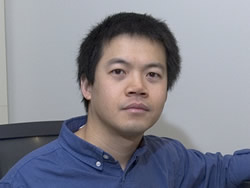The Center for Education and Research in Information Assurance and Security (CERIAS)
The Center for Education and Research inInformation Assurance and Security (CERIAS)

Two CERIAS professors have won the National Science Foundation’s most prestigious honor for outstanding young researchers.
The Presidential Early Career Awards for Scientists and Engineers total a minimum of $400,000 over five years. About 110 researchers, or roughly 20 percent of those who compete for the grants, receive the awards annually, CERIAS’ recipients this year are Cristina Nita-Rotaru and Dongyan Xu, both professors in computer science, who each received a $400,000 award.
 Nita-Rotaru is a member of Purdue’s Center for Education and Research in Information Assurance Systems, or CERIAS, and the university’s Center for Wireless Systems and Applications, also known as CWSA.
Nita-Rotaru is a member of Purdue’s Center for Education and Research in Information Assurance Systems, or CERIAS, and the university’s Center for Wireless Systems and Applications, also known as CWSA.
She established and leads the Distributed and Secure Distributed Systems Laboratory.
Her five-year study will focus on designing survivable services for wireless mesh networks.
“A network that works no matter what is one that can continue to function even if some components fail or are compromised by attackers,” Nita-Rotaru say. “This is a very complex task, particularly for collaborative environments.”
The outcomes of this research will benefit applications such as broadband home networking, community and neighborhood networking, enterprise networking, health and medical systems and surveillance systems.
As part of this award, Nita-Rotaru also will study the development of cryptographic protocols that will ensure security of wireless networks.
 Xu, who also is a member of CERIAS and works with the Cyber Center in Purdue’s Discovery Park, concentrates his computer science research in the areas of distributed computing, computer security and virtualization technologies.
Xu, who also is a member of CERIAS and works with the Cyber Center in Purdue’s Discovery Park, concentrates his computer science research in the areas of distributed computing, computer security and virtualization technologies.
“A virtual distributed environment consists of virtual machines connected by a virtual network. It is agile and self-contained with no static location on the Internet,” Xu said. “These virtual machines can ‘fly’ among physical computers and use intelligence to select the computers that best serve their computation needs. Virtualization technologies actually date to the late 1960s but have recently seen a renaissance in both academia and industry.”
Virtual distributed environments can help organizations customize their information-technology infrastructures, improve application performance and contain the negative impact of worms and viruses.
Research prototypes are being developed and deployed in physical computer clusters at Purdue.
“The same pool of physical computer infrastructures can create multiple virtual distributed environments,” he said. “A benefit of these virtual environments is that they provide a secure environment to study computer viruses, worms and spyware.
“We need an environment to observe how a worm can infiltrate a system but prevent the worm from spreading beyond our testing area”
Once the worm has “infected” a virtual machine, researchers can conduct forensic analysis on the machine.
“It is like the show ‘CSI’ but in the cyberspace,” Xu says.
Xu’s research will also encourage public use of the emerging cyberinfrastructure for many other research, education and collaboration activities.
Photos by Mark Simons